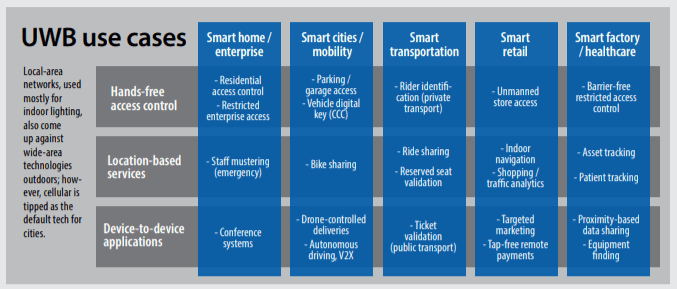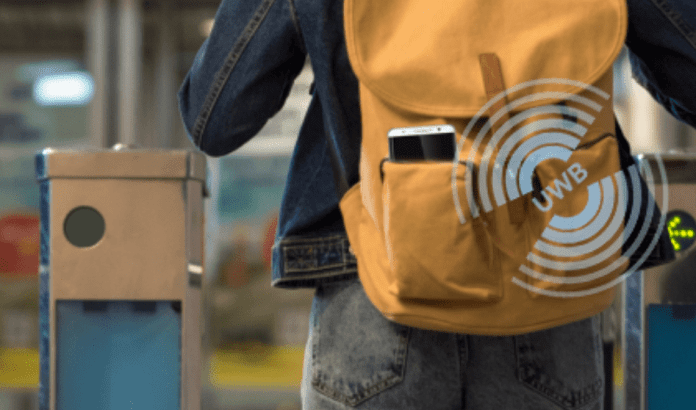The FiRa Consortium, the organisation looking to build the IoT market around the burgeoning ultra wideband (UWB) technology, is taking on new members at a decent rate. Germany-based wireless test company Rohde & Schwarz is the latest to sign up, as an associate member. It follows the likes of Thales, Cisco Systems, and STMicroelectronics to join the fray. These followed a glut of founding members, including Bosch, HID, NXP, Qorvo, and Samsung
Momentum has built around UWB as an IoT candidate technology since it was included in the late-2019 rush of iPhones. Based on the IEEE 802.15.4z standard, it uses wide spectrum (500 MHz to several GHz) and high frequency (6.5 GHz to 9 GHz), away from the busy ISM band at 2.4 GHz. It offers low-power short-range positioning (‘fine ranging’) in three-dimensional space – to about 10 centimetres, from a distance of about 200 metres.
As well as locating objects with high precision, it can track them using distance measurements between radios, and calculate time arrival and angle of movement. Ranging is achieved by time-of-flight (ToF) measurements of radar signals between devices. The FiRa (fine-ranging) Consortium says UWB outperforms other short-range technologies in terms of accuracy, reliability, and power consumption – “by a wide margin”.

UWB use cases transfer easily into industrial IoT, and other sectors. The FiRa Consortium is developing specific protocols for multiple verticals and defining parameters for a range of applications, including physical access control, location-based services, device-to-device services, and others. UWB is being positioned as a complementary low-power technology, suited to applications demanding precision location measurement and proximity awareness.
Rohde & Schwarz is developing UWB test solutions for R&D, certification, and production, including for time of flight (ToF) and angle of arrival (AoA) measurements, as well as device calibration procedures. The company’s CMP200 radio tester “solves UWB challenges” in production and development, the company said. “It combines the capabilities of a signal analyzer and generator in a single instrument,” it stated.
Its CMP200 product, in combination with its WMT software service, offers a solution for transmitter, receiver, ToF and AoA measurements in conducted and radiated mode. Its SMM100A midrange vector signal generator covers up to 44 GHz, and is the “only [one] in its class” to offer a max RF modulation bandwidth of 1 GHz, able to generate broadband signals used by UWB devices.
Alexander Pabst, vice president of the company’s wireless communications unit, said: “We recognize the power of a secure and reliable UWB technology and are pleased to strengthen our collaboration with members of the FiRa Consortium.”
Among the rush of support for the technology, semiconductor manufacturer STMicroelectronics signed a deal last year to purchase the entire share capital of France-based UWB specialist BeSpoon, to strengthen its wireless connectivity portfolio, notably its STM32 family of micro-controllers. STMicro already offers Bluetooth and IEEE 802.15.4 based products, as well as “the world’s first” LoRa-enabled system-on-chip (SoC).
Meanwhile, chipset makers Nordic Semiconductor and Qorvo announced they will collaborate on dual-mode BLE/UWB IoT products. The deal follows Qorvo’s acquisition of Ireland-based UWB pioneer Decawave in February. Decawave produces UWB solutions for mobile, automotive, and IoT applications.
As well, Dutch chip-maker NXP Semiconductors has recently expanded its UWB portfolio to include new integrated circuits (ICs) for IoT use cases including smart locks and real-time location system (RTLS) tags. NXP’s new ICs go under the Trimension brand, and take its UWB portfolio beyond mobile and automotive to embrace the busying IoT sector that has developed around the technology.
Last year, Thales joined the FiRa Consortium with a seat on the board of directors, joining Allegion, Bosch, HID, NXP, Qorvo and Samsung. Cisco Systems, Redpoint Positioning, and STMicroelectronics joined as contributor members. BlueCats, Haoyun Technologies, and Sevenhugs joined as associate members.
The consortium was further boosted last year by a joint liaison agreement with the UWB Alliance, based in the US, to work together on areas of common interest. The UWB Alliance is focused on promoting and safeguarding the technology, and on communicating updates on UWB rules in the US and Europe. The FiRa Consortium is focused on UWB use cases and specifications, IEEE 802.15.4z interoperability, and certification.

